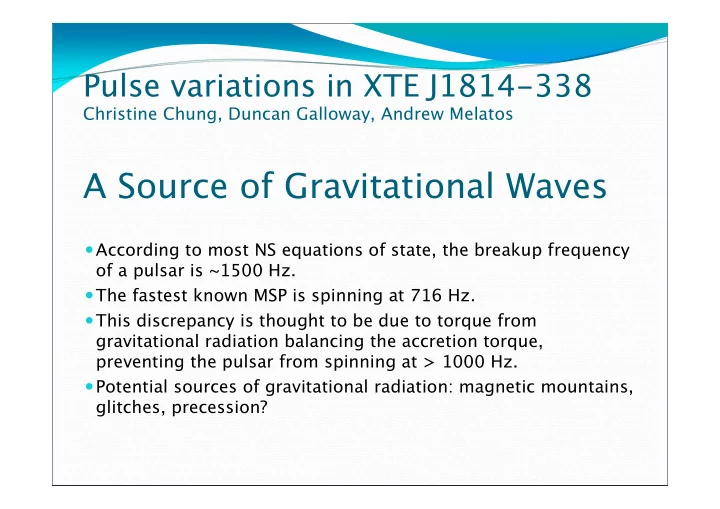

Pulse variations in XTE J1814-338 Christine Chung, Duncan Galloway, Andrew Melatos A Source of Gravitational Waves According to most NS equations of state, the breakup frequency of a pulsar is ~1500 Hz. The fastest known MSP is spinning at 716 Hz. This discrepancy is thought to be due to torque from gravitational radiation balancing the accretion torque, preventing the pulsar from spinning at > 1000 Hz. Potential sources of gravitational radiation: magnetic mountains, glitches, precession?
Gravitational Wave Detection Sources: Transient (mergers, supernovae...) Persistent (early universe, binaries, pulsars...) LIGO to detect high frequency sources (>1 Hz) AMSPs emit GW at 1x and 2x spin frequency (~1000 Hz)
Precession: Theory Two rotations: 1. Symmetry axis n d rotates about angular momentum vector J rapidly (rotation frequency Ω r ) 2. Body of pulsar rotates about n d slowly (precession frequency Ω p ) Image from http://earthobservatory.nasa.gov/Library/Giants/Milankovitch/milankovitch_2.html
Precession: E fg ects Modulation of the phase and intensity on the timescale of the precession period Previously predicted analytically for radio pulsars by Jones & Andersson (2002) ε = Ω p / Ω cos θ ε = ellipticity Ω p = precession frequency Ω = total rotation frequency θ = tilt angle
Data reduction: J1814-338 Barycentre & satellite orbit correction Background subtraction, removal of any Type 1 bursts in data Fold over spin period (~0.003s) to get pulse profiles Fit profiles with fundamental & first harmonic components: A + B sin (2 πθ + C) + D sin (4 πθ + E)
Data reduction: flux, rms & phase residuals Flux Fractional rms B/sqrt(2) A Phase residuals 0.25 – C/(2 π )
Lomb periodogram Flux period: 11.8 ± 0.8 days RMS period: 12.6 ± 0.8 days Phase residual period: 12.2 ± 0.8 days Mean period: 12.2 ± 1.3 days
Final result Phase residuals, RMS and flux are folded over the mean period, then fitted with Α + A m sin(2 π Γ + Φ ) Compare the following measured quantities to simulations: Phase residual-RMS precession phase offset, Δφ phase = 3.1 ± 0.2 Flux-RMS precession phase offset, Δφ flux = 0.7 ± 0.3 Phase residual amplitude, A phase = 0.024 ± 0.003
Simulations: parameter search Precession period determined by θ and ε Fixed parameter: ε = 0.001 Initial parameters: θ , φ , i , α (hotspot latitude) Vary these 4 parameters in search of a match to the three data values of ΔΦ phase = 3.01, ΔΦ flux = 0.7, A phase = 0.024 Generally: θ determines phase amplitude A phase i, α , ( φ ) determines precession phase offsets ΔΦ
Simulations: parameter search For most configurations of i, φ we find Δφ phase ~ π /2 Δφ flux ~ π (if hotspot is in same hemisphere as LOS) ~ 0 (if hotspot is in di fg erent hemisphere as LOS) A phase increases with ϴ (~ 0.024 for ϴ = 9°)
Is there a match? Near match for Δφ phase, Δφ flux only for i < 1° The likelihood of us seeing a pulsar with such a small inclination angle i is almost zero, assuming isotropic distribution of pulsars. Such a small i means that the fractional RMS that we'd see is also tiny, i.e. < 1% (but the data shows ~10% RMS) So, either: Our model is too simple (inaccurate surface map) The source is not really precessing.
In summary… Reduced and analysed X-ray timing data of 3 AMSPs in hopes of finding evidence of free precession Possible signal in J1814-338 Performed simulations, and found results matching the data only in the most unlikely configuration Howeve, we can estimate upper limits: • ε ~ 10 -9 , 5 < θ < 10 (inaccurate surface map) • ε cos θ < 10 -10 (no precession)
Recommend
More recommend